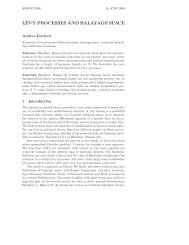Degenerate parabolic stochastic partial differential equations
Degenerate parabolic stochastic partial differential equations
Degenerate parabolic stochastic partial differential equations
Create successful ePaper yourself
Turn your PDF publications into a flip-book with our unique Google optimized e-Paper software.
4310 M. Hofmanová / Stochastic Processes and their Applications 123 (2013) 4294–4336<br />
t <br />
−→ E g(y, y, s)div σ (y) dy ds<br />
0 T N<br />
so it remains to verify<br />
t <br />
<br />
<br />
−E g(x, y, s) σ (x) − σ (y) (∇ϱ τ )(x − y) dx dy ds<br />
0 (T N )<br />
2 t <br />
−→ E g(y, y, s)div σ (y) dy ds.<br />
0 T N<br />
Here, we employ again the arguments of the commutation lemma of DiPerna and Lions (see<br />
[10, Lemma II.1], cf. Lemma 2.5). Let us denote by g i the ith element of g and by σ i the ith<br />
row of σ . Since τ|∇ϱ τ |(·) ≤ Cϱ 2τ (·) with a constant independent of τ, we obtain the following<br />
estimate<br />
<br />
t <br />
<br />
<br />
E<br />
g<br />
0<br />
T i (x, y, s) σ i (x) − σ i (y) (∇ϱ τ )(x − y) dx<br />
dy ds<br />
N T N σ i (x ′ ) − σ i (y ′ )<br />
T <br />
≤ C ess sup<br />
x ′ ,y ′ ∈T N τ E g i (x, y, s) ϱ2τ (x − y) dx dy ds.<br />
0 (T N ) 2<br />
|x ′ −y ′ |≤τ<br />
Note that according to [14,28], the square-root matrix of A is Lipschitz continuous and therefore<br />
the essential supremum can be estimated by a constant independent of τ. Next<br />
T <br />
<br />
E g i (x, y, s) ϱ2τ (x − y) dx dy ds<br />
0 (T N ) 2<br />
T <br />
<br />
≤ E<br />
g i (x, y, s) 1 <br />
2 1<br />
2<br />
2 ϱ 2τ (x − y) dx dy ds ϱ 2τ (x − y) dx dy<br />
0 (T N ) 2 (T N ) 2<br />
T <br />
≤ E (∇x u 1 )<br />
T ∗ σ (x) <br />
1<br />
2<br />
2 ϱ 2τ (x − y) dy dx ds<br />
N T N<br />
0<br />
≤ (∇x u 1 ) ∗ σ (x) <br />
L 2 (Ω×T N ×[0,T ]) .<br />
So we get an estimate which is independent of τ and δ. It is sufficient to consider the case when<br />
g i and σ i are smooth. The general case follows by the density argument from the above bound.<br />
It holds<br />
t <br />
<br />
<br />
−E g i (x, y, s) σ i (x) − σ i (y) (∇ϱ τ )(x − y) dx dy ds<br />
0 (T N ) 2<br />
= − 1 t 1<br />
τ N+1 E g<br />
0<br />
(T i (x, y, s) Dσ i y + r(x − y) (x − y)<br />
N ) 2 0<br />
x − y<br />
<br />
·(∇ϱ) dr dx dy ds<br />
τ<br />
t 1<br />
= −E<br />
g<br />
(T i (y + τ z, y, s) Dσ i (y + rτ z)z · (∇ϱ)(z) dr dz dy ds<br />
N ) 2<br />
−→ −E<br />
0<br />
t<br />
0<br />
<br />
0<br />
(T N ) 2 g i (y, y, s) Dσ i (y)z · (∇ϱ)(z) dz dy ds.



